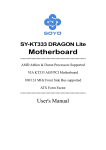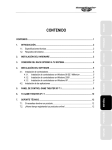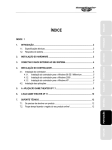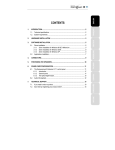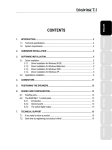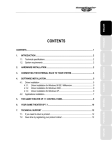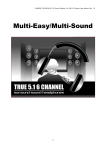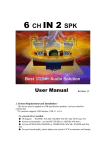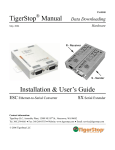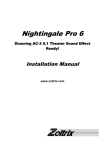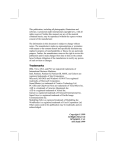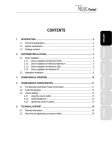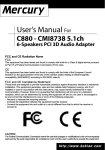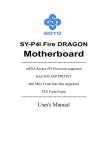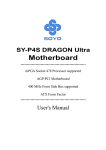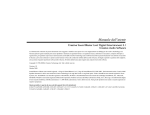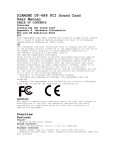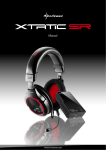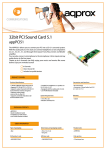Download Asound aw450 - Arx Valdex Systems
Transcript
AW840/850 Series Audio Card User’s User’s Guide Rev. 2.1 2002/07/02 AOpen AW840/850 Series Sound Solution User Manual Rev. 2.1 Table of Contents Preface………………………..………………………………………………………2 1. AOpen AW840/850 Series Audio Chip Advantages……………………….3 1.1 C3D HRTF Positional Sound Solution..……………………………………..3 1.2 EnvironmentFX Sound Effects……………………………………………….5 2. Product Specification………………………………………………………..….8 3. Installation/Uninstallation Procedure...…………………………………..…..9 4. AOpen Power Mixer…………………….……………………………………….14 5. Windows Applications--Audio Rack………………………………….……..18 6. Multi-Channel Audio Demo……………………………….…………………..24 Appendix A—The 4 Speakers System…………………………………………30 Appendix B—SPDIF I/O Function……………………………………………….31 Appendix C—Solution For Mini Disc Players…………………………………32 Appendix D—Recording From SPDIF-In……………………………………….35 1 AOpen AW840/850 Series Sound Solution User Manual Rev. 2.1 Preface The manual is a user guide for using AOpen AW840(4Ch)/850(6Ch) Series PCI multi-channel audio device correctly and it also provides the overview of the versatile product features and TM value-added advance audio technology such as 3D, EAX , etc.. The document is protected by copyright and all rights are reserved. No part of this manual can be reproduced by any form without prior permission of AOpen Inc.. This PCI Audio Adapter offers a new generation PCI audio solution: it utilizes the state-of-the-art CRL® 3D Audio technology (HRTF 3D positional audio), and supports Microsoft® DirectSound ® 3D and Aureal®’s A3D® interfaces. Better yet, it supports 2/4/6 speakers and DLS based (Downloadable Sound) wave table music synthesizer which supports the DirectMusic®. Besides being legacy audio SB pro® compatible and providing professional SPDIF IN/OUT non-distortion digital interface, it also supports MPU-401 interface, dual game ports, etc. What we provide at the side of the sound card is line-in/rear speaker jack, microphone jack, audio output jack, SPDIF/OUT jack, and 15pin D-SUB multiplexed joystick/MIDI connector. TM Moreover, this PCI audio solution supported Sensaura EnvironmentFX sound effects to TM compatible with EAX 1.0 & 2.0 specifications. The environment modeling technology takes PC audio to the next level of realism. Not only the sounds themselves, but also the acoustic contribution of the environment envelop the listener and give vital clues about the positions of TM sound source. EAX surround sound effects and HRTF 3D-position engine to make the popular application-3D gaming perform more realistic by high-quality hardware support to satisfy numerous PC gamers. Trademark Acknowledgements Microsoft, Windows, DirectSound 3D, and DirectMusic are trademarks of Microsoft Corporation. Sound Blaster is a trademark of Creative Technology, Ltd. Sensaura TM EnvironmentFX is a trademark of Sensaura, Ltd. Aureal is a trademark of Aureal Inc. A3D is a registered trademark of Aureal Inc. C3DX™ is a trademark of CMEDIA electronics Inc. All other trademarks and registered trademarks mentioned in this manual are the property of their respective holders and are hereby acknowledged. FCC Compliance Statement Certified to comply with the limits for a Class B computing device according to Subpart J or Part 15 of FCC rules. The information in this manual is subject to change without notice. Please go to AOpen Website to search update information. HTTP://WWW.AOPEN.COM.TW/ 2 AOpen AW840/850 Series Sound Solution User Manual Rev. 2.1 1. AW840/850 Series Audio Chip Advantages 1.1 C3D HRTF Positional Sound Solution The C3D technology is licensed from CRL (Central Research Lab.) and later enhanced by CMedia. It uses an audio filter called Head Related Transfer Functions (HRTFs). The basic concept of C3D is: since we can hear sound three dimensionally in the real world using two ears, it must be possible to regenerate the same sound effects from two loud speakers. What is HRTF? HRTF (Head Related Transfer Functions) is a set of audio filters which are varying locations of sound effects (spatial hearing cues) in three-dimension measured from the listener's eardrum. Using this technology and special digital signal processing to re-create spatial hearing cues allow our ears hear a realistic and three-dimensional sounds coming from a pairs of loud speakers or headphones. There are several listening cues, which allow us to hear sounds three-dimensionally: (I) Spatial hearing : Primary 3D-cues . IAD The head shadowing effect creates differences in the amplitudes of the sound signals arriving at each ear from the source. The effects of diffraction are most noticeable in the range between about 700 Hz to 8 KHz, where the A and S functions periodically converge and diverge gently. This Inter-aural Amplitude difference (IAD) is one of the primary 3D sound cues. . ITD In addition to the IAD, there will be a time-of-arrival difference between the left and right ears, unless the sound source is in one of the pole positions (i.e. directly in front, behind, above and below). This is known as the Inter-aural Time Delay (ITD). . Pinna Effects 3 AOpen AW840/850 Series Sound Solution User Manual Rev. 2.1 It has been assumed by some researchers that the convolutions of the pinna create the spectral features, which constitute the 'height' cues. In practical experiments by Gardner, in which different parts of the pinna were occluded, and then the ability of a number of subjects to identify sound source positions at different heights was tested, it was shown that the different features all contributed by different amounts. For example, if the fossa is excluded, then height localization capability is impaired, but not totally extinguished. It would be reasonable to conclude that it is the combined effect of the pinna convolutions which creates the various localization cues, and it is not valid - or logical - to attempt to assign particular spatial capabilities with individual physical features. (II). Spatial Hearing : Secondary 3D-cues (Shoulder & Local Reflections) In addition to the 'primary' 3D sound cues (IAD, ITD and pinna effects), there are several additional cues, which do contribute to the localization capability; these will be referred to here as 'secondary' cue, and include should/torso reflections, local room reflections, and psychological cues. .Shoulder / Torso Reflections The presence of a torso attached to an artificial head has the effect of increasing the pressure in the vicinity of the ear up to frequencies of around 2 kHz. The effect is greater for frontal sources than lateral sources. In the experience, the presence of the torso does not appear to contribute much to spatial accuracy. However, shoulders are located very close to the ears, and their effect is greater, this time, in respect of lateral sounds. If one listens to an artificial head first without, and then with, shoulder fitments, then it is clear that the shoulders do contribute to spatial effects in certain positions. The shoulders provide a strong reflection from lateral sources, with a short path-length of around 10 cm between direct sound and reflection. The effects are most important for side-positioned sources, especially for "height" effects, where the shoulders tend to mask sources which move below about 30 degrees depression. .Local, Room Reflections In simulations, it is clear that the incorporation of first-order simulated room reflections can help in the creation of sound images, which have a "solid" nature. However, the effects - if accurately simulated - are relatively slight. Experience has shown that it is primarily the quality of the HRTFs themselves, which determine the quality and solidity of the sound image. The further addition of second-order reflections does not help significantly, because in reality, there are a great number of reflections in the average room. A method which does help to recreate the acoustic experience of a room, however, is to use approximate simulations of lateral reverb, using either 2 or 4 laterally placed "virtual" sources at, say, +-70 degrees and 80 degrees azimuth. The quality of the sound image relates to the HRTFs used. The quality of the room image relates to addition of reflections and reverb. .Psychological Cues There are clearly psychological cues present in every day’s life, which work together with the audio cues. For example, if you hear the sound of a helicopter flying, you expect it to be up in the air, not downwards. If a dog were barking nearby, you would expect it to be downwards. 4 AOpen AW840/850 Series Sound Solution User Manual Rev. 2.1 How to Listen to C3D Sounds Correctly? .Use Headphones to Have Much Better Effects When you use headphones in listening, there will be less interference such as outside noise or room reflections comparing to using speakers. .Choose Correct Output Device Choose the correct output device in the options of demo program in accordance with what listening device you want to listen to. Because listening through speakers must be proceeded by crosstalk cancellation, if you choose the incorrect output device, there won’t be any 3D positional audio effects. .Locations of Speakers If you listen from speakers, please do not mix up the left and right speakers. They must be in equal distance from you. That means you, the left, and the right speaker must be in the topmost of a right triangle. Your position is so-called “sweet spot”. In addition, the height of your ears and the height of the speakers must be the same. .Turn Surround Sound Functions off When the surround sound effects are enabled, it will cause confusion with C3D sound, and make positional sound effects invalid. 1.2 EnvironmentFX TM Sound Effects TM The killer application of PC is 3D gaming in consumer market, and hence EAX Compatible surround sound effects and HRTF 3D-positional engine become very important and necessary TM features to satisfy massive gamers. Sensaura EnvirnonmentFX modeling technology was TM one of world famous EAX Compatible surround sound effects. It’s refers to the way in which sound travels to the listener’s ears in a particular acoustic environment such as a room. A sound generated within a room travels in many directions. Somewhat later, he or she hears a 5 AOpen AW840/850 Series Sound Solution User Manual Rev. 2.1 number of discrete echoes caused by sound bouncing once off nearby walls, the ceiling and the floor. To simulated the various sound effects in different distances, spaces, and mediums of the real world. Take a close and spacious room for instance; human ears will hear lots of reflection and echo in addition to the sound source. The results will change according to different environments. Direct-to-reverberant sound ratio Room Size High frequency cut-off Early reflection level Reverberation Level Reverberation & Frequency decay time Density Diffusion Detuning TM There are currently hundreds of PC games that use EAX compatible surround sound effects and HRTF 3D positional audio. The most popular games almost need to support above function effects. These will make 3D game more realize and to vibrate every 3D gamer. Defects of 2CH HRTF 3D on PC Application General Description Use HRTF with crosstalk cancellation X-filter to create a semi-actual and semi-virtual 3-dimensional audio environment Headphones Use HRTF to create a semi-actual and semi-virtual 3-dimensional audio environment Speakers Advantages Low cost Front effect OK Low cost Rear effect OK Disadvantages Rear effect comparatively weak Sweet spot limitation Front effect comparatively weak Discomfort in long-time wearing Once audio can more realizes and various, people will ask it to upgrade to fulfill sense of they hearing. Not only get 3D positional and environment sound effects but also to feel reality and have a great impact on their experiences to be personally on the scene. Therefore 2CH stereo surround sound to switch multi-channel sound system and application HRTF 3D technology on 6 AOpen AW840/850 Series Sound Solution User Manual Rev. 2.1 multi-channel system, like 4 or 5.1CH mode. This cloud enlargement sweet spot and construction an comfortable listening quality. General Description 4CH Speaker System 5.1CH Home Theater Speaker System Use HRTF technology with 4 or 5 actual speakers to create a 3-dimensional encompassing listening environment. Major Benefits Sweet spot enlargement; comfort and ease in listening Good output quality for both front and rear Sweet spot enlargement; comfort in listening Good output quality for both front and rear Additional spatial effect reinforcement for front center output To create the listening environment with actual speakers seemed perfect in the first place, but again problems ensued. First, there must be extra space for rear speaker arrangement (you don’t want 4 or 5 speakers buzzing right next to your ears, do you?). Second, how to fix the rear speakers? No matter to wall-mount them or put them on tripods is somewhat technically challenging to the general public. Third, how to cope with those long and winding wires for the rear speakers? Try to think how many times you’ve been stumbled by those wires… For reasons above-mentioned, peoples need a wonderful multi-channel audio solution. Not only solved these problems but also reserve all advantages with multi-channel sound system, especially direction of HRTF 3D audio and virtual-reality environment sound effects. Furthermore, the earphone like solution should allow the listener to perceive the front signal at the same time and no more discomfort in long-time wearing. To find a perfect balance between user-friendliness and 3D positional audio quality. 7 AOpen AW840/850 Series Sound Solution User Manual Rev. 2.1 2. Product Specification Special Features AW840-L is a 4 Channel Sound Card (WITHOUT SPDIF IN/OUT) AW850-L is a 6 Channel Sound Card (WITHOUT SPDIF IN/OUT) AW850-Pro is a 6 Channel Sound Card (WITH SPDIF IN/OUT) PCI Plug and Play (PnP) bus interface, 32-bit PCI bus master. Full-duplex playback and recording. Built-in 16-bit CODEC. HRTF-based 3D positional audio (C3DX™) for earphone and 4 / 6 CH speakers output, supporting both DirectSound 3D® & A3D® interfaces. Comprehensive driver support: Windows 98/98SE, Windows ME, Windows 2000, Windows XP and Windows NT 4.0 Linux, BeOS, etc…. MPU-401 Game/Midi port and legacy audio SB Pro support. Downloadable Wave Table Synthesizer, supporting Direct Music®. Professional digital interface, supporting 24-bit SPDIF IN/OUT (Hardware 44.1K and 48K in/out).(For AW850 Pro only) Microphone echo and Karaoke ascending/descending key effects. Single chip design, digital power +3.3V, analog power +5V, 128 pins QFP. Digital Audio (SPDIF IN/OUT) Up to 24-bit stereo 44KHz sampling rate; voice playback/ recording. Full-duplex playback and recording. 120dB audio quality measured. Auto detectable SPDIF/IN signal level from 0.5V to 5V. 120dB audio quality in playback, recording, and bypass modes. Stereo Mixer Stereo analog mixing from CD-Audio and Line-in Stereo digital mixing from Voice, FM/Wave-table, and Digital CD-Audio Mono mixing from MIC Software adjustable volume. Game and MIDI Interface Fully compatible with MPU-401 Midi UART and Sound Blaster Midi mode/Standard IBM PC joystick/game port (dual channels) 8 AOpen AW840/850 Series Sound Solution User Manual Rev. 2.1 3. Installation/Un-installation Procedure 3.1 DOS Installation Before the installation, please make sure that your hard disk has sufficient space (min. 4MB). Insert the Driver CD into the CD-ROM Drive. Change directory to PCI audio DOS drivers folder (ex. D:\DOSDRV) at DOS prompt, and type: INSTALL [Enter] Type the DOS utilities path you want to install the file in. Program will expand the file to the path you've specified. Install program will add initial drivers into AUTOEXEC.BAT file. 3.2 Win95/98/98SE/ME/2000/XP Installation AOpen audio device driver and software media application provide much more than your imagination. When you insert installation CD, set up program will automatically pop up installation dialog box and user can follow the program step by step to completed set up. Insert installation CD Set up program will pop up dialog box as follow: You can select to install driver and application of them. To install Application, User can choose favorite language This dialog box was reminded you some information about agreement. 9 AOpen AW840/850 Series Sound Solution User Manual Rev. 2.1 Select folder to set up program. (Recommend select as default setting) 10 AOpen AW840/850 Series Sound Solution User Manual Rev. 2.1 Proceeding install procedure (Include components copy and device search…) Setup program will extract Microsoft DirectX and Direct media components. After copy and extracting, set up program will install device driver and this step will take some time, please be patient. When finished set up the program will pop up a dialog picture to show multi-channel speaker environment. User should select which speaker mode he or she wants. 11 AOpen AW840/850 Series Sound Solution User Manual Rev. 2.1 After whole installation procedure has finish, you will need to restart your computer for enable driver and application functions. 3.3 Win95/98/98SE/ME/2000/XP Un-installation If you want to remove audio driver or application you can use uninstall function on “PCI Audio Application”. The uninstall program will confirm your step. If you want to remove those programs then click “Yes”. When you click “Yes”, program will remove files and components. 12 AOpen AW840/850 Series Sound Solution User Manual Rev. 2.1 3.4 Windows NT 4.0 Installation We recommend that you install Windows NT 4.0 before you install this PCI audio card, and you not install any other sound card device drivers in your current system. 1.Click “Start”, move the highlight bar to “Setting”, and select the “Control Panel”. 2.Double-click “Multimedia”. 3.Select “Devices”, and press “Add”. 4.Select “Unlisted or Updated Driver” in “List of Drivers”. 5.Specify the drive path where NT drivers are in (such as D:\NT40\DRV). 6.Select “AW8X0/C-MEDIA CM8738,” and press “OK”. 7.Select proper I/O value. 8.Press “OK.” 9.Restart the system when being asked. 10.Now, you have already installed the PCI Audio Adapter under Microsoft Windows NT 4.0 successfully. if you want to install the Windows applications, continue the following steps: 11.Click “Start”. 12.Select “Run”. 13.Key in drive path where the Windows NT application installation program are in; for example, “D:\NT40\APP\SETUP.EXE” 14.Click “OK” to start the installation procedure, and follow the on-screen instructions to complete the installation. When all of application software has been installed, shut down the Windows NT system, and then reboot your system. 13 AOpen AW840/850 Series Sound Solution User Manual Rev. 2.1 4. AOpen Power Mixer Volume Control For each output signal, the control slider regulates the loudness whereas a horizontal slider the balance between the two speakers. The mute button can temporarily stop the output without changing slider positions. A button with a lit LED means the output is available, and vice versa. Several output signals can usually be enabled at once. Volume: This is the master control over all outputs. The power of an outputRe signal is determined by both of the volume slider and the slider for the individual output. To modify all the outputs, adjust the volume slider. To change individual output(s), adjust its(their) slider(s). CD: Regulates the CD drive audio input level. MIC: Regulates the input level of microphone. WAVE: Regulates wave (voice) playback levels. MIDI: Regulates the MIDI music play level. AUX IN: Regulates the Auxiliary input play level. MONO IN: Regulates the Mono input level. LINE IN: Regulates the Line-In levels. Advanced: Regulates the advanced settings. Recording Control For each input signal, a control slider regulates the loudness whereas a horizontal slider the balance between the two channels. The select button can temporarily select input signal without changing slider positions. A button with a lit LED means it is available, and vice versa. CD: Regulates the CD drive audio input level. MIC: Regulates the input level of microphone. WAVE: Regulates wave (voice) playback level. FM: Regulates the FM music play level. AUX IN: Regulates the Auxiliary input play level. 14 AOpen AW840/850 Series Sound Solution User Manual Rev. 2.1 LINE IN: Regulates the Line-In level. SPDIF IN: Enables the recording from SPDIF in. SPDIF-in is mutually exclusive with other input signals. Advanced: Regulates the advanced settings. Advanced Dialog Box Advanced – SPDIF (Sony/Philips Digital Interface) SPDIF dialog provides a full control over SPDIF IN/OUT functions. You can use these settings to connect your computer to other pieces of audio device, such as: Mini Disc players, amplifiers…etc. 1. To enable SPDIF-OUT should be under 2-channel speaker mode since SPDIF standard only supports 2ch PCM audio data. If users would like to transmit multi-channels audio through SPDIF, users should choose AC-3 Dolby encoded format or DTS like DVD titles. Users can choose 44.1K or 48K Hz sampling rate of PCM data when using SPDIF-Out. 2. SPDIF Input Loopback is used for digital-in to digital-out. 3. Monitoring is used for digital-in to analog-out. 4. Validity Detection is for data validity/correction check. 5. Format option is reserved for input digital data phase inverse since some source data may has reverse phase. 6. Device option is for choosing SPDIF input channel (8738 supports two SPDIF-In channels). 7. The Copyright Protection is to enable SPDIF Copyright bit. Then recording copyrightprotected input data will be not available. For more information of SPDIF, please refer to the Appendixes C and D. 15 AOpen AW840/850 Series Sound Solution User Manual Rev. 2.1 Advanced –Speakers (General Mode) Speakers dialog box provides an interface allowing you to set your speaker mode. AW840/850 Series supports earphone, 2ch, 4ch, and 5.1ch mode. 1. The “Configuration” tag shows the speakers figure corresponding to your setting. 2. The “Phone Jacks” tag shows the correct phone jack configuration for your Motherboard/sound card. First, you should make sure what type your speakers are, and what the correct configurations are. You can always refer to this to make sure whether or not the connections of your speakers and plugs are correct. 16 AOpen AW840/850 Series Sound Solution User Manual Rev. 2.1 Advanced - Sound effects Sound effects dialog allows you to modify the special environment sound effects of the song and game being played. Currently, these effectors can only be used for the player or the game which utilizes DirectSound 2D and 3D to playback their music. Virtual 5.1 option will try to simulate surround sounds even your digital audio sources are only 2 channels. Advanced - Options Options dialog provides a hot key setting to control the Mixer in an easy way. Please note that this might affect other applications if you use the same hot key setting. Please use 'Load Mixer Defaults' to change all settings to default values. “Enable Microphone Booster” will enable +12dB microphone input signal gain. 17 AOpen AW840/850 Series Sound Solution User Manual Rev. 2.1 5. Windows Applications—Audio Rack Audio Rack (for WDM driver) By means of a user-friendly interface (as easy as operating your home stereo system), this PCI audio rack provides you with control over your PC’s audio functions, including the advantage of 4/6 speakers mode enable/disable, and perfect digital sound (SPDIF) input /output control. Control Center Control Center: Controls the display of the PCI Audio Rack components. This Audio Rack consists of several major components: CD Player can play standard audio CDs, and allow you to create your own playlist. MIDI Player can play MIDI files, *.mid/*.rmi, and allow you to create your own playlist. MP3/Wave Player can play mp3, wave, and MPEG-1 files. It provides EAX and equalizer to improve the sound effects when you playback the audio files. If you want to sing a song, MP3/Wave Player also provides a Karaoke function. MP3/Wave Player can record input signals and save it in a wave file as well. Mixer controls the volume level of your audio inputs and outputs. Showing or Hiding Audio Rack Components To show or hide a component from the display, click the component button(s) listed on the top. CD Player CD Player: Plays standard audio CDs, and allows you to create your own playlist. 18 AOpen AW840/850 Series Sound Solution User Manual Rev. 2.1 Current Track field shows the number of the currently selected CD track. CD title and track name field shows CD title and track name. You can modify CD title and track name in [Playlist] function. Total length field displays the total length of the selected track in minutes and seconds. Playback time field displays the current playback time. Button Function Playlist: You can select or move tracks of audio CD from and into the playlist. The title of CD and the name of tracks can be modified as well. Playlist dialog will save and show them automatically when you want to play the same CD. Previous song: Loads the previous track of playlist. If current track is the first track, the last track will become the current track. Next song: Loads the next track of playlist. If current track is the last track, the first track will become the current track. Playback: Starts to playback the current track. Pause/Restart: Pauses or restarts the current playback action. Stop: Stops playback. Playback backward for 10 seconds: Playback the current to 10 seconds before. Playback forward for 10 seconds: Playback the current to 10 seconds after. Loop: Playbacks the tracks over and over again. Eject: Opens the CD-ROM drive to change the audio CD. Setting: Selects the CD-ROM drive which analog output is connected to the Analog-CD in of your sound card. If your CD-ROM does not connect to the analog CD input wire, please use device manager to change the property of your CD-ROM. 19 AOpen AW840/850 Series Sound Solution User Manual Rev. 2.1 Help: Shows the help screen for detailed button function descriptions. About: Shows software version and copyright information. Exit: Stops and leaves the CD player. MIDI Player MIDI Player can play MIDI files, *.mid/*.rmi, and allow you to create your own playlist. Current file field shows the number of the currently selected MIDI files. File name field shows the file name. Total length field displays the total length of the selected file in minutes and seconds. Playback time field displays the current playback time. Button Function Playlist: allows you to insert, remove, and record the MIDI files into and from the playlist. You can save the playlist into a file as well. Previous song: Loads the previous MIDI file of playlist. If current file is the first MIDI file, the last one will become the current selection. Next song: Loads the next MIDI file of playlist. If current file is the last one, the first file will become the current selection. Playback: Starts to playback the current MIDI file. Pause/Restart: Pauses or restarts the current playback action. 20 AOpen AW840/850 Series Sound Solution User Manual Rev. 2.1 Stop: Stops playback. Playback Backward for 10 seconds: Playback the current to 10 seconds before. Playback Forward 10 seconds: Playback the current to 10 seconds after. Loop: Playbacks the MIDI files of the playlist over and over again. Setting: Selects the output device you want to use to playback the MIDI files. Help: Shows the help screen for detailed button function descriptions. About: Shows software version and copyright information. Exit: Stops and leaves the MIDI Player. MP3/Wave Player MP3/Wave Player can play mp3, wave, and MPEG-1 files. It provides EAX and equalizer to improve the sound effects when you playback the audio files. MP3/ Wave Player can record input signals and save it into a wave file as well. Current file field shows the number of the currently selected audio files in the playlist. Frequency display field shows the frequency distribution. Total length field displays the total length of the currently selected file in minutes and seconds. Playback time field displays the current playback time. File name and status field displays the file name, audio format, sound effects selection, playback mode, Karaoke mode, and SPDIF status. Button Function Playlist: Playlist allows you to insert, remove, and record the audio files into and from the playlist. The audio files include wave, MP3, and MPEG-1 encoding files. 21 AOpen AW840/850 Series Sound Solution User Manual Rev. 2.1 Previous song: Loads the previous audio file of playlist. If current file is the first file, the last one will become the current selection. Next song: Loads the next audio file of playlist. If current file is the last one, the first file will become the current selection. Playback: Starts to playback the current audio file. Pause/Restart: Pauses or restarts the current playback action. Stop: Stops playback. Playback backward for 10 seconds: Playback the current to 10 seconds before. Playback forward for 10 seconds: Playback the current to 10 seconds after. Sound effector: You can use this function to modify the special effect of the song being played. Currently, these effectors can only be used for 44.1 KHz, 16-bit format. Recording: You can use this function to record a wave file from any recording channel. 22 AOpen AW840/850 Series Sound Solution User Manual Rev. 2.1 Setting: You can use this dialog to set the playback parameters and the status of SPDIF IN/OUT. For more information of SPDIF, please refer to the Appendixes C and D. Help: Shows the help screen for detailed button function descriptions. About: Shows software version and copyright information. Exit: Stops and leaves the MP3 player. 23 AOpen AW840/850 Series Sound Solution User Manual Rev. 2.1 6. Multi-Channel Audio Demo AW840/850 Series PCI-Based C3DX Audio Chip provides many advanced functions, such as: ® ® HRTF-based CRL 3D extensional/positional audio; API compatible with Microsoft ® ® DirectSound 3D and Aureal A3D API. Supports rear side speakers; C3DX positional audio in 4/6CH speakers mode. (5.1 CH, DVD AC-3 available). Compatible with EAX TM ® home theater (Environment Audio eXtention). KARAOKE ascending/descending keys, Echo. Supports Center/Subwoofer side speakers. (for chip model 039 and the following models). To let everyone avail himself/herself of the above functions, a user-friendly interface (Multi-Channel Audio Demo) was designed with the following functions: 4 CH speakers mode, including Demo1 and Demo2. EAX TM (Environment Audio eXtention) support. ® HRTF-based CRL 3D extensional/positional audio. KARAOKE ascending/descending keys, Echo, and microphone ascending/descending keys. 6 CH speakers mode, including Demo1 and Demo2. (for chip models 039 and the following models). Speakers and Microphone Connection Before running this demo program to feeling the AOpen’s Sound Banquet, you have to connect the speakers and the microphone to the correct phone jacks. Generally speaking, there are four ways for hardware connection (sound card and motherboard): 24 AOpen AW840/850 Series Sound Solution User Manual Rev. 2.1 Five phone jacks. How to Enable 4/ 5/ 5.1 Speakers You have to activate the "Mixer" program and click “Advanced” button. Then you can open speakers page and selected "4-Speaker", "5 Speakers", or "5.1 Speakers" mode to let the audio driver recognize your rear or center/subwoofer speakers, and have the front/rear/center/subwoofer speakers work. The audio driver will activate the audio chip to output different sounds from the front/rear/center/subwoofer speakers based on different playback formats. For more information, please refer to the “9 AOpen Power Mixer”. Beside this, you can open multi-channel audio program and click the “TV” on home theater graphic picture. The program will pop up a dialog box to set up advanced setting. 25 AOpen AW840/850 Series Sound Solution User Manual Rev. 2.1 How to Adjust the Microphone Volume You have to use the microphone when availing yourself of the "Echo" function. If the microphone is on and is very close to the speakers, it will cause feedback between the two. Also, unusual high frequencies or buzzing sounds might be heard from the speakers. To avoid this, you have to adjust the microphone volume in both recording and playback. Sometimes you might have to adjust the main and Wave volume as well. Please left-click the mouse to adjust the microphone (MIC) in both Volume and Recording Control. Test Your Speakers Connection To make sure that the front and the rear speakers are correctly connected, you can use the following program to testify individual speaker output. Move cursor to whichever speaker you want to test and left-click the mouse. If the setup is correct, you can hear music coming from that speaker alone. Each music output is different for distinction. 26 AOpen AW840/850 Series Sound Solution User Manual Rev. 2.1 You can move your mouse on any speaker, which at the graphic user interface. When you click speaker then its will sound from correct channel. Demonstrations AOpen provided three music melodies, which are specially designed for Multi-channel speakers system demonstration. Select Music by left-clicking the mouse. Sit back and relax, and let the music take control. How was it like? Isn't it fantastic??? If you don't have multi-channel speaker system, hurry up and buy yourself one right away! EAX Monotonous footsteps generate distinctive sound effects in different environments. In this Demo, you can hear a lady wearing high heels walk in different surroundings: generic environment, bathroom, sewer pipe, and underwater. Left-click the mouse to activated this Demo and feel the differences. 27 AOpen AW840/850 Series Sound Solution User Manual Rev. 2.1 HRTF HRTF stands for Head Related Transfer Functions, and it is a set of audio filters varying locations of sound effects (spatial hearing cues) in three-dimension measured from the listener's eardrum. This technology and special digital signal processing are used to recreate spatial hearing cues, making our ears hear realistic and three-dimensional sounds coming from a pairs of loud speakers or headphones. When you activate this Demo, you can simply shooting, fire missile and fly helicopter. 28 AOpen AW840/850 Series Sound Solution User Manual Rev. 2.1 Echo Like to sing along with Karaoke? It might occur to you to use your PC for this. However, when you turn on the microphone, play the song, and ready to sing, you see that the effect is not as good as expected. Why? Echo is the answer. To help you solve this problem, this demo is designed to include the Echo function. Please left-click the upper right of the demo screen as shown below, and choose your own music file to play. Please note the file type has to be MP3 file. Please left-click "Echo" to activate the function. For pitch adjustment, please use ↑ and ↓ keys on the keyboard. For microphone pitch adjustment, please use "+" and "-" keys on the numeric keyboard. To resume the original, please use← and → keys. 29 AOpen AW840/850 Series Sound Solution User Manual Rev. 2.1 Appendix A—The 4 Speakers System This audio adapter provides 2 wave channels(front/rear), known as the 4 speakers system. When games or application programs locate the sound sources via DirectSound® 3D or A3D® interface to the listener's back, the two rear speakers will work to enhance the rear audio positional effects, so as to complement the insufficiency of using only two front speakers. The following is the hardware installation and the software setups: The installation of your front and rear speakers. Connect the front speakers to the Line-out jack of the audio adapter, and then connect rear speakers to Line-in/Rear jack of the audio adapter. The original Line-in can be moved to Aux-in. The positions of the speakers Put your speakers the way the following picture suggests, so as to avail yourself of the optimal audio results. The mixer setup There is a 4 speakers option in the volume control of the mixer. When you enable this option, it means the rear speakers are connected to Line-in/Rear jack. When Line-in/Rear jack is connected to other external Line-in sources, please DO NOT enable this option in order to avoid hardware conflicts. Regarding rear speaker option, you can turn on or turn off the output of the back speakers, and adjust the volume to have the rear/front speakers have the same output volume. The HRTF demo The HRTF demo is the "Helicopter" demo with C3D HRTF Positional Audio. When the helicopter flies behind you, the rear speakers will work. "Multi-Channel Audio Demo" is a wonderful demo of 4 speakers system as well: you can use it to find out whether or not the positions of your speakers are correct. 30 AOpen AW840/850 Series Sound Solution User Manual Rev. 2.1 Appendix B—SPDIF I/O Function S/PDIF (Sony/Philips Digital Interface) is a standard audio transfer file format. It’s usually found on digital audio equipment such as a DAT machine or audio processing device. S/PDIF interface allows the transfer of audio from one file to another without the conversion to and from an analog format, which could degrade the signal quality. The most common connector used with an S/PDIF interface is the RCA connector and optical connector.( Optical Module DIP SW Setting) 31 AOpen AW840/850 Series Sound Solution User Manual Rev. 2.1 Appendix C—Solution For CD & Mini Disc Players The MP3 player has been catching people's attention ever since its debut, as this pocket size player provides people with a more convenient access to the MP3 music enjoyment (in the past, it requires a PC to play MP3 music). Free download from the Internet, coupled with the easy-to-carry size, prompt many people to purchase a MP3 player with 64M bytes flash RAM, capable of playing music for sixty minutes. Nevertheless, the MP3 player is not that convenient as imagined. First, if the users get tired of the stored music, they have to go back to their PCs for new download (it will cause inconvenience if they are out for travel and have no access to the Internet). Even if a flash RAM can be added to the MP3 player for memory extension, still a problem exists. That is, who wants to spend nearly USD100 in order to save 5 songs/titles? With the same budget (USD200), isn't there a better solution for the MP3 player? MD (Mini Disc) player is the answer. The MD player has been available at the consumer electronics market for a period of time, and its popularity keeps growing in places like Japan, Hong Kong, and Europe. Each MD player is capable of storing high quality 74-minute music, and one blank MD costs less than USD2.00-4.00. More importantly, the most high-end 24-bit MD player costs around USD200. Since there is no expensive memory design, there is room for the MD player to drop its price. Compared with the MP3 player, the MD player surely got the upper hand. The MD player is destined to be a hot seller; nevertheless, there is one big problem with the MD player application. That is, the MD player cannot be directly connected to the PC. To remove this obstacle, AW840/850 Series offers an excellent solution: the optical fiber interface. The optical fiber interface within the sound card can provide easy access to people who want to digitally record the MP3 music on their PC to the MD player. The optical fiber interface offers two applications: the output and the input. . The Output: PC to MD player: this includes CD audio to MD player, WAV to MD player, and wave-table music to MD player. <CASE-1> PC's CD-ROM player to the MD player 32 AOpen AW840/850 Series Sound Solution User Manual Rev. 2.1 <CASE-2> Portable CD-ROM player to the MD player. PC to AC3 decoder or DAC. The Input: The MD player to PC: the optical in can accept digital audio from the desktop MD player or high-end CDs, and store it in 24-bit WAV format. Hi-end CDs to PC (with optical out) 33 AOpen AW840/850 Series Sound Solution User Manual Rev. 2.1 Using MP3/Wave Player to Work With Mini Disc Recording MP3/Wave Player is an easy and powerful tool for Mini Disc recording. Besides allowing you to create your own playlist, it also provides a control interface of SPDIF IN/OUT of AOpen's sound card. The following 4 steps can help you create your album into Mini Disc easily. STEP 1.Using optical fiber to connect the sound card and the MD player. MD player will start to do the recording and turning on the SYNC mode. (See above 1. Output A. PC to MD player) STEP 2.To execute MP3/Wave Player and modify the playlist. You should select those files whose format can be recognized by the MD Player. You can also change the sound effects if you like. (See also 5.1.4.) STEP 3.In 'Setting' dialog, check 'Enable SPDIF-OUT', input the playback delay time, and select 5 Vp-p (Optical). Please note that in playback, if there is no lapse longer than three seconds between each track, the MD player cannot recognize the tracks and will record all of them into one. It is recommended that you set the lapse time to 3~5 seconds to meet all type of MD player requirements. STEP 4.Start to play the songs. You will see that the MD player starts to do the recording as well. 34 AOpen AW840/850 Series Sound Solution User Manual Rev. 2.1 Appendix D—Recording From SPDIF-In The optical module can be connected to SPDIF-IN device, such as the portable CD-ROM player, the CD-ROM drive, the MD Player, to name a few. The Windows application and the MP3/Wave player can be used to do the recording of the signal from SPDIF-IN. The recording steps are as follows: STEP 1.Use optical fiber or coaxial to connect the sound card and SPDIF-IN device. (See also Appendix C 2. Input) STEP 2.Execute MP3/Wave Player. In 'Setting' dialog, select 5 Vp-p (Optical) or 0.5 Vp-p (Coaxial). STEP 3.In 'Wave Recording' dialog, you should select the recording format and SPDIF-IN recording channel. Then input the file name. Before recording, please turn on your SPDIF-IN device and start to playback. Finally, press 'Record' to start the recording process. 35




































